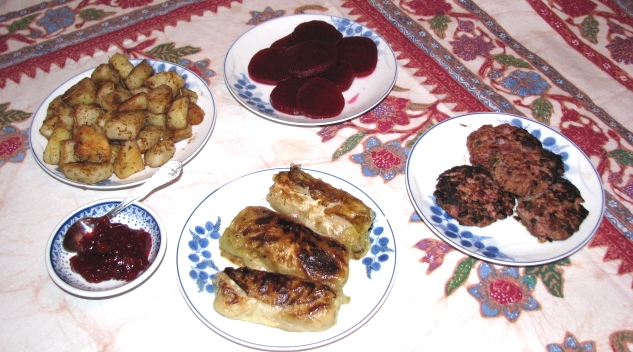
Here are a couple of recipes from the Scandinavian country of Sweden. Often prepared at Christmas time, they can be enjoyed all year long.
Beef Lindström
Most people are familiar with the Swedish word, Smörgåsbord, which is commonly used in America to describe a robust variety of just about anything. Most people also know that the origin of the meaning comes from the Swedish buffet style of serving food for a social occasion. The word is a contraction of "open faced sandwich" and the Swedish word for table, bord. The most elaborate version of smörgåsbord is called julboad (roughly Christmas table, jul=yule). Swedish smörgåsbords consist of a large variety of dishes. Bread, cheese, and butter are essential for a smörgåsbord but other offerings include cold, either pickled or smoked fish dishes (salmon, herring and eel), ham (with mustard), meatballs, crab canapés, sausages, potatoes (done up many ways), hardboiled eggs, cabbage, beets, pickles, cabbage rolls (kåldolmar) mushroom or shrimp omelettes (with béchamel sauces), and more. Usually the dinner follows a progression of eating cold fish dishes to meat cold cuts and finishing off with warm dishes such as Swedish meatballs (köttbullar).
Straight shots (snaps) of strong Swedish alcoholic spirits (notably, aquavit) often heighten the enjoyment of smörgåsbord, a commensal ritual that was immortalized in the song "Smorgasbord and Schnapps" by jazz great Duke Ellington. Not so rarely a Swedish dinner might be kicked off with several rounds of the drinking song Helan Går (which literally means "The whole thing goes down"). The song is so well ingrained that when Sweden won the World Ice Hockey Championship in 1957, after it was discovered that some of the players didn't know all of the words to the Swedish National Anthem, the team decided instead to sing Helan Går!
It is believed that Biff à la Lindström was brought to Sweden in 1862 by Henrik Lindström who was born and raised in St. Petersburg Russia by his Swedish parents. The addition of beets to the recipe reflects the Russian culinary influence.
Beef Lindström Ingredients
- 1 1/2 pound ground (minced) beef
- 4 egg yolks
- 1 yellow onion
- 1 cup pickled beets with juice
- 1 ounce capers
- salt
- butter
- white pepper
Preparation:
- separate 3 egg yolks into a small bowl
- Finely chop 1/2 of a yellow onion
- Dice the pickled beets into small pieces
- Mix the ground beef with the egg yolks, a little water, plus salt and pepper into a smooth mixture
- Blend into mixture the onion, capers and beets plus a hearty splash of the beet juice
- Shape into small round patties
- Fry the beef patties in butter until golden brown on both sides
Kåldolmar
Kåldolmar are Swedish cabbage rolls usually stuffed with rice and either ground or minced beef or pork or a combination of the two. Similar to Biff à la Lindström, Swedish cabbage rolls may have a transcultural origin. As the story goes, after being defeated in the Battle of Poltava by Tsar "Peter the Great" of Russia, the bellicose (no adjective was ever more apt) Swedish king Charles XII fled to Moldavia which was then under control of the Ottoman Empire. The Swedish king spent the next half decade in Ottoman controlled lands before he was able to resume his passion for war with his northern neighbors.
Voltaire was so fascinated by Charles XII that he wrote a biography of him and the English poet penned a poem about Charles entitled, "The Vanity of Human Wishes" which contains the line, "Peace courts his hand, but spreads her charms in vain; 'Think nothing gained', he cries, "till nought remain".
The Swedish word Kåldolmar is a contraction of "Kål" meaning cabbage and "dolmar" derived from the Arabic word for grape leaves, dolma. It is thought that when Charles XII returned to Sweden, either he or his Ottoman creditors brought with them to Sweden the art of making stuffed grape leaves.
The first Swedish literary mention of dolmas (then still made with grape leaves) may be found in Anna Christina Warg's 1755 book Hjelpreda I Hushållningen För Unga Fruentimber (Assistant in Housekeeping for Young Women) which became for many decades a leading household guide for women in Sweden, Finland, and Germany.
While Kåldolmar are often eaten with boiled or mashed potatoes—now considered essential staples in Sweden—Warg's guide pre-dates the introduction of potatoes into the Swedish diet.
So interconnected are Kåldolmar, Charles XII and Swedish national identify that the Friends of the Cabbage Roll (Kåldolmens vänner) created the holiday "Kåldolmens dag" (Day of the Cabbage Roll) which is commemorated on November 30th, the day of Charles XII's death.
Kåldolmar Ingredients
- 1/2 cup white (short grain is best) rice
- 1½ cups milk
- 1/2 pound of ground beef
- 1/2 pound of ground pork
- 1 head of cabbage
- ½ cup water
- salt, white pepper, thyme
- margarine or butter
- ½ cup light cream
Preparation
- Remove the leaves from the cabbage and boil them in salted boiling water. If the leaves are hard to remove,cut around the bottom of the cabbage where the leaves attach to the base. Then stick a fork in the base of the cabbage and then lower the cabbage into boiling water. In less than a minute the outer leaf will soften to the point that it may be separated from the leaf below it. Tranfer the leaves to a bowl near the boil pot. Use rubber gloves and be very careful so that you don't injure yourself by the steam or boiling water!
- Return the loose leaves to the boiling water and cook them until they are slightly transluscent (about 5-6 mins)
- Remove cooked leaves from the boiling water and shake the water off or dry them with paper towels
- Trim the coarse centre vein of each cabbage leaf (or trim the lower part of the leaf)
- Cook rice in a covered pot until the rice is almost done (about 12 minutes after water comes to a boil) Note, different kinds of rice require different amounts of water, follow rice package instructions to learn proper amount.
- Stir in milk and cook till the mixture stiffens
- Let rice cool and then add meat and spices to the mixture
- Put a large tablespoonful of filling on each cabbage leaf
- Fold the leaf around the filling like you would a burrito or an egg roll
- Heat butter on medium heat in a skillet and lightly brown the Kåldolmar on both sides
- Transfer rolls to a casserole or wide pot
- Spear each roll with a toothpick or two to ensure the rolls don't unravel in the pot.
- Cover rolls with water (or beef broth) and simmer for 15 minutes
- Add the cream and cook for another 15 minutes
Both Biff à la Lindström and Kåldolmar can be complimented by some lingonberry preserve which can be obtained at any Ikea store restaurant.
Recipe by T. Johnston-O'Neill
Photo by Shari K. Johnston-O'Neill








